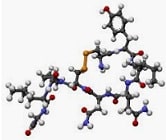The etymological origin of the term oxytocin that concerns us now is found in Greek. Specifically, it derives from words like “oxytókos”, which can be translated as “that fertilizes quickly”, or “oxytókion”, which is what the medicine that was responsible for accelerating childbirth was called.
Likewise, we can establish that it is the result of the sum of two lexical components of Greek:
-The adjective “oxys”, which is synonymous with “acute”.
-The noun “tokos”, which can be translated as “birth”.
Oxytocin is a hormone : the product of the secretion of a gland. In this case, the person responsible for production is the pituitary gland , which is located at the base of the skull.
 All hormones, when circulating through the circulatory system, are responsible for regulating, inhibiting or exciting the activity of a system or an organ. Oxytocin has the function of stimulating the contraction of the uterus and the secretion of milk in the breast.
All hormones, when circulating through the circulatory system, are responsible for regulating, inhibiting or exciting the activity of a system or an organ. Oxytocin has the function of stimulating the contraction of the uterus and the secretion of milk in the breast.
As you can see, oxytocin plays a very important role in childbirth and feeding the baby . This hormone contributes to childbirth and then promotes the ejection of milk from the mammary gland.
To generate the release of oxytocin, the body must receive stimuli , such as distension of the cervix or sucking of the nipples. These types of actions trigger the secretion of the hormone.
Beyond these issues, oxytocin also affects behavior in different ways. It is often called the “love hormone” , since the sweating and palpitations that a person usually registers when feeling in love are linked to the action of this substance.
In the same way, it is common to also talk about oxytocin as the hormone of happiness. And that is the feeling you have when it is released when doing physical exercise, singing, hugging a loved one, dancing or singing, for example.
It should be noted that the medicine that is made with this hormone is also called oxytocin. Because the gastrointestinal tract destroys it, it is necessary to administer it as a spray to be inhaled or through injections .
Oxytocin is used to induce labor and to help with the release of breast milk. Specifically, it is considered that labor should only be induced by injecting the patient with oxytocin when her contractions do not cause adequate dilation of the cervix. However, this injection can also be used to induce delivery when for other reasons it is necessary to act quickly on behalf of the mother or even the baby to be born.
Among the potential side effects in these cases are high blood pressure , tachycardia and postpartum hemorrhages .
However, other side effects of the aforementioned oxytocin are nausea, vomiting, the appearance of a rash, an itchy sensation, and there may even be some difficulty swallowing or even breathing.
